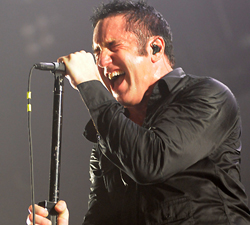
It gave Keppler the time to really focus on preparing his mix. “I’d sit myself in an isolated room with my Genelec loudspeakers and really listen to what was truly was coming off the stage as opposed to through a PA system that I’m not as familiar with.” The ability to save mix settings as snapshots during this time proved a godsend for both audio engineers.
The consoles being used at both FOH and monitor positions that give both engineers the flexibility of snapshot pre-sets are the small-footprint Digidesign Profiles. Despite its footprint, the console provides a potential of 96 inputs, 73 of which are being used on this tour.
Prowda has been using Digidesign consoles since the inception of his relationship with NIN when he took an early software version of the Venue on the road for the With Teeth tour. “I definitely needed some kind of technology where I could do snapshots. With the in-ear thing there’s less slop involved. You have to be more exact with the mixes for everybody. The way I was dealing with it before was that every song would be on an index card. I’m a real fan of this console right now. I don’t feel that anybody’s come up with anything I’ve seen that’s really been worth my attention.”
Keppler has over 50 snapshots of EQ, compression, basic effects and level settings stored in his FOH console. This helps get him through a show that he describes as having the potential to become “chaotic” on any given night. But snapshots are not the only benefit of the Profile console for Keppler: “It just sounds good. It’s got more life to it than some of the other digital consoles. I love it. I don’t know what I would do without it at this point.”
A large part of the “chaos” that Keppler describes as inherent in a NIN show comes in this case from the current tour’s Ghosts segment. Ghosts I-IV is a double CD of over 30 instrumental tracks released by Reznor in early 2008.
On tour, this segment, like the recording, features instrumentation that is largely acoustic and includes, amongst other things, a full size marimba, harmonium, glockenspiel, upright bass and various junkyard percussion instruments. This can be a mixing challenge for Keppler in an environment that requires the same SPLs as the rest of the show but is much more inherently conducive to excessive mic bleed.
Add to that the fact that the songs in the section change from night to night and the challenge intensifies. One problem in particular derives from the mic used on the marimba and its ideal sonic placement. The mic is a Royer SF24 stereo ribbon. This type of mic is a seemingly unlikely choice for a tour like this but during rehearsals, Prowda had ribbon mics on the brain after watching a DVD of The Band’s Last Waltz.
He contacted Royer who responded by dropping off two ribbon mics they consider road-rugged: the stereo SF24 and R121. The R121 found a place on the kick drum during rehearsals and although Prowda and Keppler loved the sound, “We kind of chickened out because it’s not a cheap mic to re-ribbon.” Initially, the SF24 sat on a shelf for the same reason until Trent Reznor announced his inclusion of songs from the Ghosts album to the set list. When a 5 ½-octave marimba showed up the SF24 was “un-shelved.”
Although they considered using a transducer system, they tried more conventional live mics and even briefly dealt with a MIDI mallet pad and sampler, in the end the SF24 just sounded too good to pass up.
Other microphones on stage for the tour come from Shure, Sennheiser and Audio-Technica. Prowda noted that he likes the fact that Reznor uses a SM58 for vocals as it forces him to sing right into the mic, making it very in-ear monitor friendly.
For those who have not heard any NIN recordings, they are very effects driven and can rely on a lot of intricate mix automation and editing. Keppler maintains, however, that he was under no pressure from Reznor to adhere to the mixes on the studio recordings. Keppler nonetheless includes a fair number of effects plug-ins in his own arsenal.
Prowda also uses several plug-ins on his monitor board, but professes to be a lot less “plug-in happy” than he was when he first started using Digidesign consoles. Some of the effects Keppler and Prowda swear by include: Digidesign’s Smack!, SansAmp, Echo Farm and Reel Tape Suite, Sony’s Oxford Reverb, and TubeTech’s CL1 B compressor.
